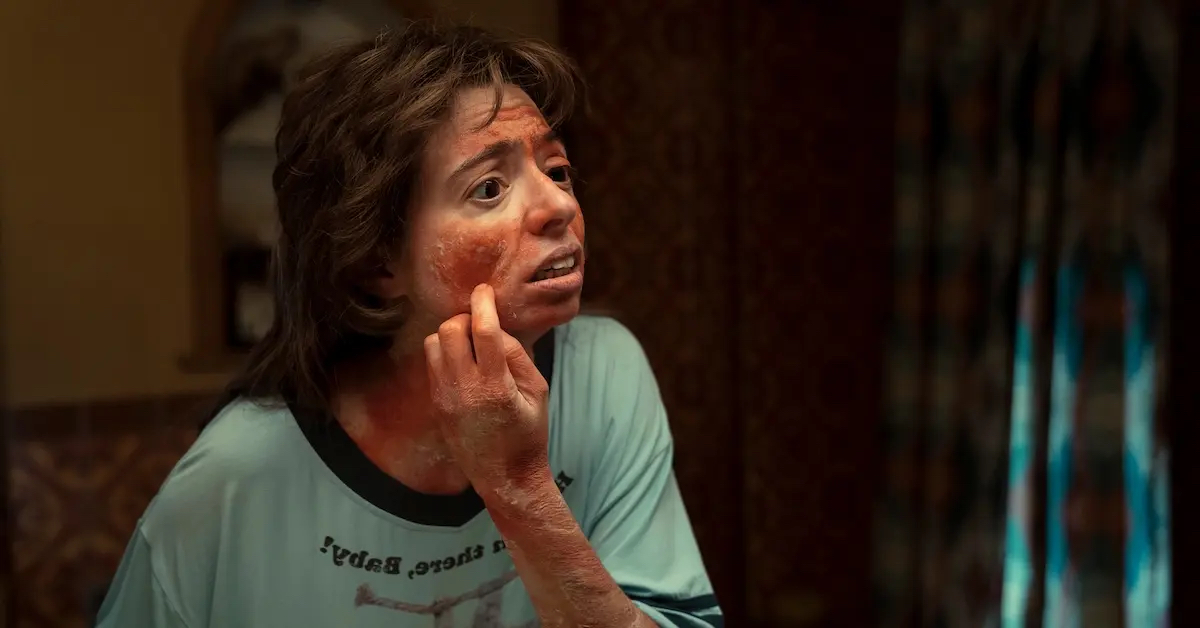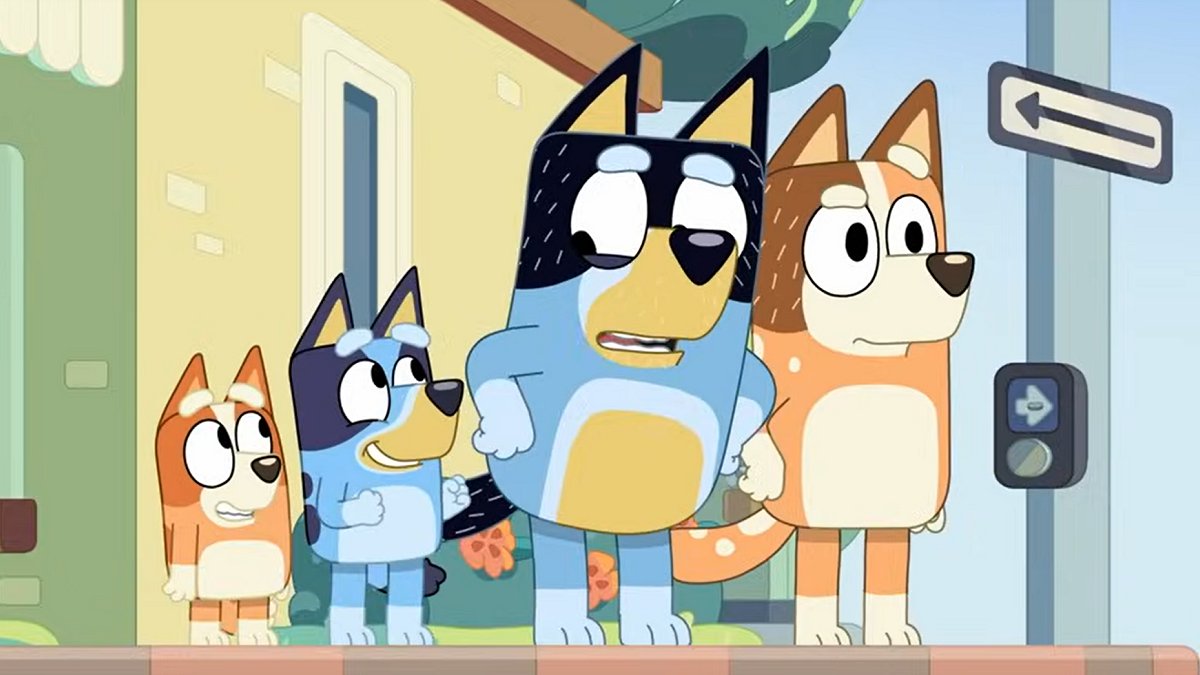“Beauty is only skin deep,” the old adage says, but Ana Lily Amirpour asks, what if skin is all we are?
In the fourth episode of Guillermo del Toro’s Cabinet of Curiosities, titled “The Outside” and directed by Amirpour (A Girl Walks Home Alone At Night), we meet Stacey. Stacey (played by Kate Micucci) is a mousy awkward bank teller struggling to fit in with her more glamorous (well, for the 1980s midwest) co-workers. Stacey wears bulky sweaters, eats microwaved hot wings, has a long mullet, and her favorite hobby is taxidermy. Still, she fantasizes about becoming a hair-sprayed, shoulder-padded, McMansion-owning diva like Gina, the queen bee of the bank tellers.
She finally has an opportunity when she is invited to Gina’s private holiday party and is gifted with Alo Glo – a hot new skin care product she has seen advertised on late-night infomercials and that the women at her work are obsessed with.
Unfortunately for Stacey, she has an allergic reaction and her face becomes a giant ugly rash. But Stacey, (coaxed by a devious Dan Stevens as the Alo Glo salesman ) refuses to stop using the lotion. Her loving husband watches in dismay as she continues to coat herself in the goo, and grows increasingly frustrated as she ignores his pleas for her to stop hurting herself. But she is determined to remake herself and the episode’s climax culminates in a grisly murder and a disgusting goo bath full of Alo Glo.
But Stacey achieves her dream. She steps out of the bath reborn. Her skin is clear, her lazy eye is fixed, her teeth are straight. She has the confidence to cut her hair and put on makeup. She enters the bank a new woman. Her coworkers are amazed and enthralled. She laughs with her newfound feminine power, but as the credit rolls she mugs for the camera, the discomfort and fear still bulging in her eyes.
The horrors of performing gender
Because what “The Outside” truly captures is the horror inherent in attempting to perform traditional gender roles. The pain of performativity and interpellation. Interpellation, for all of us who need a Louis Althusser refresher, is a way to explain the process of internalizing and accepting the dominant culture’s ideas as our own. When Stacey watches her infomercials and parrots the sales lines from the Alo Glo man she is interpellating. When she mimics the motions of her co-workers, the constant rubbing of the lotion into their hands, when she then obsessively rubs the lotion into her own hands, she is adopting that feminine gesture, that role, and attempting to make it her own. Even if she has to force it.
And Stacey does have to force it. The lotion burns. It leaves her red and disfigured. It leaves her skin pealing and flaky. This perfect ideal of femininity is not natural to her. In fact, as we watch the lotion ooze out of its bottles and flood her basement of its own volition, we the audience can see that this isn’t natural for maybe anyone at all. But gender, much like Stacey’s Alo Glo applications, is a continuous act. And it is very hard to stop. Or as Judith Butler describes it in Gender Trouble, it is “the repeated stylization of the body, a set of repeated acts within a highly rigid regulatory frame that congeal over time to produce the appearance of substance, of a natural sort of being.”
And congeal it does. The lotion, like “femininity,” must be applied over and over and over again. Stacey has to endure the pain and maintain the process so that the gelatinous Alo Glo monster in the basement can continue to harden and take shape. In the end, when she follows the Alo Glo being into the tub, she sinks in and fully submerges herself, letting it coat and congeal around her.
The temptation to belong
But why does Stacey crave this? We see in the story that the women she admires are vapid and frivolous. They laugh and they gossip and they preen. They are an army of nearly identical mavens with their matching coiffes and lycra power suits. They aren’t mean, they don’t bully her so much as they ignore her, but they aren’t interesting. They don’t have much going on.
But they do belong. They fit in with the world and with each other. And as we see Stacey’s longing lingering gaze upon their silky skin and shiny hair we can see that they are seductive.
In fact, at the holiday party, we watch them alongside Stacey as they massage and stroke each other. Rubbing the lotion into each other’s hands and decolletage. The sequence is absurd but erotic – tantalizing. We watch them as they rub over and over again. And we watch Stacey later, on her own, mimic that gesture.
It is the temptation of belonging. The seduction of society. Existing on the fringe is difficult and lonely. Especially when one can not conform to the expected societal gender role assigned. The ability to perform gender successfully is an act (or series of continuous acts) of survival. Because as we know, those who can not perform their gender correctly are always punished by society. They are a part of the pack. And Stacey is not. They have community. And Stacey is alone.
But what about her husband? You ask. And yes, Stacey does have a husband, (played by the always wonderful Martin Starr), and he is kind and supportive and loves her for who she is. In fact, he repeatedly tells her that she does not have to fit in, that she should stop using the Alo Glo. That she should be content being herself, after all, he fell in love with her for who she is on the inside and the outside. Her goal for her makeover is not, as one might expect, to land a man but to land friends. To find her place in their world. A lover and companion are not enough. No man is an island and two people are not a community.
And so his words ring hollow. His love is not enough. As Stacey angrily tells him, it’s easier for him to be a slob to drink beer, to not worry about how he looks, because those are all actions that are acceptable and expected for men. He has his place. He fits in. And so he can not understand what it is like for her that she can not. He can not fully grasp the horror of her loneliness.
And when he threatens her transformation, she snaps. She stabs a scalpel into his forehead and chops him repeatedly with an axe. In so doing, she has removed the final barrier, the final piece of herself preventing her metamorphosis. Stacey finally becomes one with the Alo Glo and nothing of her old self can remain. But what was her old self really? A woman struggling to achieve societal expectations of beauty except in her taxidermy.
Gender as Taxidermy
Her taxidermy becomes the final metaphor. The process of gutting an animal, and replacing its innards with styrofoam and wires, and leaving only the beautiful exterior intact. Stacey, we see, is a skilled taxidermist. We watch as she taxidermies her animals, and then her husband, and finally, the process that we’ve been witnessing all along, the taxidermy of herself. Each lotion application, each peal of her skin, is like the tanning of a hide or the scraping of the insides of that poor duck that she gifts to Gina.
Much as Judith Butler, and to some extent Althusser, describes the performance of gender and the interpellation of gender roles as a continuous act (or system of acts) that reveals there is no inner self, there are only our actions of ourselves, Stacey too becomes a hollow shell. She becomes the Alo Glo. She becomes the taxidermied duck. There was no inner Stacey that Keith her husband valued so highly, there was only this.
There was only the outside.
(Image: Netflix)









